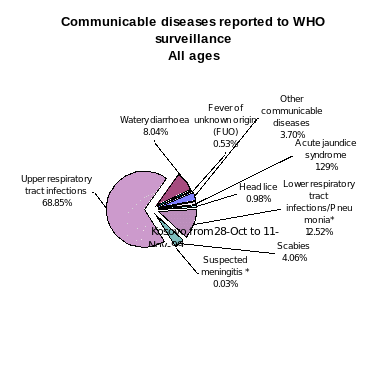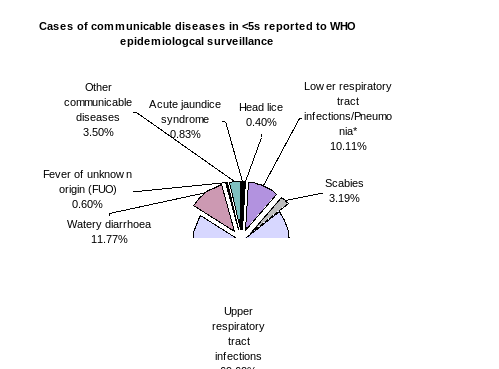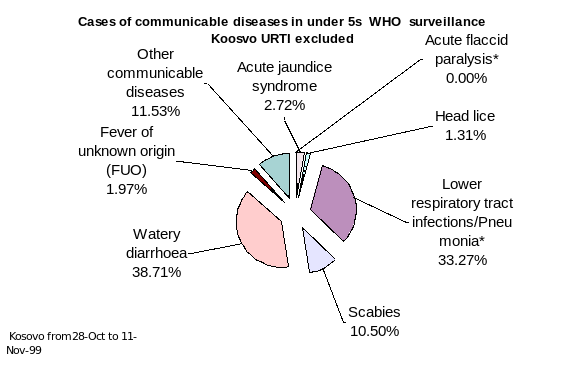WHO EPIDEMIOLOGICAL SURVEILLANCE UPDATE 281099 TO 111199 10130 CASES
DENTAL EPIDEMIOLOGICAL SURVEY OF ‘RISING’ 12 YEAR OLD CHILDRENNATIONAL EPIDEMIOLOGICAL SURVEILLANCE CONFIRMED INVASIVE MENINGOCOCCAL DISEASE PUBLIC
WHO EPIDEMIOLOGICAL SURVEILLANCE UPDATE 281099 TO 111199 10130 CASES
Update from the WHO epidemiological surveillance and outbreak investigation system
WHO EPIDEMIOLOGICAL SURVEILLANCE UPDATE
28/10/99 to 11/11/99
10,130 cases of communicable diseases were reported by 36 primary health care facilities. Out of 29 municipalities, WHO has received reports from 16 for this period.
Municipalities and facilities/NGOs that have reported are:
|
Municipalities |
Facilities/NGOs |
Municipalities |
Facilities |
|
Deqan |
Memisa, J-RCS,IRC |
Obiliq |
Ambulanta, MDM-F |
|
Ferizaj |
Health House, Hospital, |
Peja |
MC Hospital, MeRu, MSF, ambulanta |
|
Gjakova |
Memisa |
Podujeva |
Health house |
|
Gjilan |
Ambulanta, IMC |
Prishtina |
MDM- F, MDM-E |
|
Gllogovc |
MDM-F |
Rahovec |
Health house, MDM-F, HaFo eV |
|
Istog |
IMC, MSF, Health House |
Shtime |
Health House |
|
Kamenica |
IMC |
Prizren |
IPH, HaFo eV |
|
Klina |
Health House |
Vitia |
IMC |
The largest number of syndromes – 25% or 2529 cases - were reported from Ferizaj municipality, including 2120 upper respiratory tract infections (URTI), 78 lower respiratory tract infections (LRTI), 137 watery diarrhoea (WD).
Other high reporting municipalities are Deqan with 14.8%- of the total (URTI 879, LRTI 428, WD 80 Total 1506) Prizren with 13.5%- (URTI 923, LRTI 163, WD 248. Total 1509), Peja with 12,32%-(URTI 754, LRTI 184, WD 95, total 1252)
Unfortunately not all of the reports are from individual health facilities. Therefore, these proportions do not represent the actual incidence in the regions. Health facilities are asked to send to us individual reports from health facilities, as well as the catchment area, in order to create more accurate incidence rates.
|
Cases of communicable diseases reported to WHO surveillance system 28-October to 11 November 1999 |
|||
|
|
0-4 Years |
Over 5 years |
Total |
Disease/Syndrome |
Cases |
Cases |
Cases |
|
Acute flaccid paralysis* |
0 |
0 |
0 |
|
Acute jaundice syndrome |
29 |
102 |
131 |
|
Bloody diarrhoea * |
0 |
1 |
1 |
|
Head lice |
14 |
85 |
99 |
|
Lower respiratory tract infections/Pneumonia* |
355 |
913 |
1268 |
|
Measles * |
0 |
0 |
0 |
|
Neonatal tetanus |
0 |
0 |
0 |
|
Scabies |
112 |
299 |
411 |
|
Sexually transmitted diseases* |
0 |
2 |
2 |
|
Suspected cholera * |
0 |
0 |
0 |
|
Suspected meningitis * |
0 |
3 |
3 |
|
Suspected typhoid fever* |
0 |
0 |
0 |
|
Upper respiratory tract infections |
2443 |
4531 |
6974 |
|
Watery diarrhoea |
413 |
401 |
814 |
|
Fever of unknown origin (FUO) |
21 |
33 |
54 |
|
Other communicable diseases |
123 |
252 |
375 |
|
Total |
3510 |
6622 |
10132 |
* denotes diseases that should be reported immediately
Analysis
The most common diseases reported were upper respiratory tract infections 68.8% and lower respiratory tract infection 12.5%. Watery diarrhoea cases accounted for 8% of the cases. Among the under 5s 69.6% of reported cases are upper respiratory tract infection. Watery diarrhoea accounts for 11.7%, while 10.01% are lower respiratory tract infection cases.
Compared with the previous reporting period (14 - 28 Oct 99), there is no a significant change in the proportions of conditions. There is a slight increase in upper respiratory tract infection cases in under 5s (63.6% to 69.6%), while reported cases of watery diarrhoea have decreased from 14.6% to 11.7%.
If we exclude upper respiratory tract infection cases, due to their low priority for public health action the proportions by condition are as follows:
All ages Under 5 years:
Lower respiratory tract infection 40,2% 33.2%
Watery diarrhoea 25,8% 38.7%
Scabies 13.0% 10.5%
Acute jaundice syndrome 4.1% 2.7%
Diarrhoea
The analysis shows a high level of diarrhoea in under 5s – almost 40% of the total cases). The main reason for this is likely to be the low level of knowledge of proper child nutrition, together with poor personal and food hygiene. Health workers need to promote breast feeding practices and personal hygiene especially hand washing after defecation and before feeding children.
Scabies
Analysis shows that the number of scabies cases is increasing and, with the onset of winter, crowded living and poor hygiene conditions, as well as the population’s low level awareness of scabies treatment, there is risk of this increasing further. Pharmaciens sans Frontieres as coordinating agency for drug distribution in Kosovo is attempting to ensure that enough anti-scabies medications are available. WHO would also encourage NGOs, and all health workers to use all the available methods of health education to promote and improve good personal hygiene behaviour.
Investigation and response
Acute jaundice syndrome
131 cases of acute jaundice syndrome have been reported during this period. Thirty four cases were reported from Prizren, 39 from Podujevo and 36 from Ferizaj. Compared with the previous period, this is a slight increase in reported cases.
Meningitis
Three suspected cases of meningitis were reported from Prizren, one was reported in the period 28 October – 04 November, and two of them in the period 5 –11 November. IPH/WHO Prizren have followed up the cases, but no feedback has yet been received.
Mumps
Investigation: On 4 November 1999, Medecins du Monde-Sweden informed WHO of 20 cases of mumps seen by the doctor on 1 & 2 November at Krvasari ambulanta, Malisheva municipality.
WHO/IPH epidemiologist conducted field visits on 5 and 11 November respectively to investigate reported cases of mumps. The technician in charge of the vaccination centre of Malisheva Health House, as well as the nurse at the ambulanta from which cases were reported have been interviewed, and some of the patients visited. All the required information for epidemiological investigation of the cases (line listing) were collected and the suspected cases followed up.
Outcome: seven confirmed mumps (parotitis epidemica) cases. These cases were family-related, most were in children aged 10-12 years, with a week’s difference between onset of disease. The families had all been refugees in Albania, and there were other sporadic cases of mumps from same families reported in the previous months.
Outbreak status was not confirmed, but health authorities are urged to be vigilant on early detection and notification of cases, proper case management (isolation of cases and contacts), and outbreak prevention. The importance of the good vaccination coverage should also be highlighted.
Information: According to the IPH epidemiologists, no vaccination against mumps was done from 1992- 1996 in Kosovo because of lack of vaccine.
Scabies
A high number of scabies, 365 cases in Kosturiq and Gllogjan village, were reported by Medecins sans Frontieres in Peja. WHO has asked for confirmation of these reports.
Information about a large number of cases of scabies in Meje village, Gjakova municipality, was reported to WHO on 16 November 99 by the Centre for Protection of Women and Children, Prishtina.
WHO, in coordination with PSF, the NGOs responsible for the area, and local health authorities will conduct necessary activities including screening of population for scabies, distribution of leaflets and guidelines for prevention of spread of infection as well as medications for scabies treatment.
Hepatitis A in Pristina University Hospital
The University of Pristina Infectious Diseases Hospital has received over 500 Hepatitis A cases in the past five months. This is thought to be around twice as many as in previous years. WHO has assessed the situation regarding these cases and found both the figures and the state of the hospital facilities to be disturbing. To ameliorate this situation, WHO has asked PSF to ensure there are adequate drug supplies and has provided protective equipment for staff to reduce the risk of cross contamination.
|
Hepatitis A case inpatients at the University of Pristina Infectious Diseases Hospital |
|||||
|
M Number of cases |
June 10 |
July 103 |
August 129 |
September 137 |
October Total 124 503 |
In order to practice a good epidemiological surveillance, preparedness and response WHO urges medical doctors/NGOs medical coordinators to follow the guidelines for epidemiological surveillance (copies available from the WHO office).
WHO would like to thank agencies for sending their reports and would encourage them to improve completeness, timeliness and accuracy of these reports.




Tags: 111199, surveillance, cases, 10130, update, 281099, epidemiological
- JOSEFINA CRUZ VILLALÓN SECRETARIA DE ESPAÑA DE INFRAESTRUCTURAS
- ASAMBLEA POPULAR 4 DE JUNIO 2011 CIUDAD ÁNGELES –
- TÍTULO DE TÉCNICO EN FARMACIA FORMACIÓN PROFESIONAL ESPECÍFICA DE
- SISTEMA EUROPEO E INTERAMERICANO DE PROTECCIÓN DE LOS DERECHOS
- XXXVI REUNIÓN DEL GRUPO DE REVISIÓN DE LA IMPLEMENTACIÓN
- BASES REGULADORES DEL PROCÉS DE SELECCIÓ PER COBRIR EL
- P OLSKI REJESTR PACJENTÓW Z CHOROBAMI NERWOWO – MIĘŚNIOWYMI
- COLEGIO “JUAN XXIII” CENTRO PRIVADO CONCERTADO DISCÍPULAS DE JESÚS
- EMERGENCY MEDICAL TECHNICIANBASIC NATIONAL STANDARD CURRICULUM EMTBASIC NATIONAL STANDARD
- LEAD–BASED PAINT CERTIFICATION LEAD–BASED PAINT CERTIFICATION APPLICATIONRECEIPTINVOICE FOR FIRMS
- LA GENERALITAT MESTRE A CASA ERROR TWITTER
- LEY FEDERAL DE LAS ENTIDADES PARAESTATALES CÁMARA DE DIPUTADOS
- PLAN DE EVOLUCIÓN TECNOLÓGICA PARA QUE PUEDAS TRABAJAR EN
- PROBABILIDAD EJERCICIOS PROPUESTOS EJERCICIO 1 CON LOS JUGADORES
- ALICANTE 14 DE OCTUBRE DE 2014 RENOVACIÓN DE LA
- JOYCE JOHNSON REEDSBURG AREA HIGH SCHOOL REEDSBURG WI 53959
- GPIX005049252013 ZARZĄDZENIE NR 49252013 PREZYDENTA MIASTA STOŁECZNEGO WARSZAWY Z
- BUSQUEDAS BIBLIOGRAFICAS 1BUSQUEDA LIBRE CON PUBMED Y UTILIDADES BUSCAR
- ILLETÉK BÉLYEG HELYE 3000 FT IKTATÓSZÁM BEHAJTÁSI ENGEDÉLY KÉRELEM
- PIETEIKUMS GRĀMATVEŽU UN AUDITORU PROFESIONĀLĀS ATBILDĪBAS APDROŠINĀŠANAI¹ ŠIS PIETEIKUMS
- TOWARDS A MORE EFFECTIVE METHOD OF SCHEDULING RESOURCECONSTRAINED MULTIPLE
- LOS CONTENIDOS DE LA UNIDAD DIDÁCTICA DE RELIGIÓN PROGRAMACIÓN
- XXVII TROFEO GUERRITA –MEMORIAL JUAN ROMERO Y DIEGO SÁNCHEZ
- AGENCY TRANSITION GUIDELINES THE AGENCY COMMITTEE SHOULD FAMILIARIZE THEMSELVES
- PROGRAMUL DE DEZVOLTARE A JUDEŢULUI MUREŞ 2007 2013
- KLASA UPI351031402154 URBROJ 51706221156 ZAGREB 7 SIJEČNJA 2015 MINISTARSTVO
- WC6 – VERSION 21 (22062020) GUIDANCE NOTES WINDOW CLEANERS
- REQUEST FORM – ACCESS TO EXHIBITS THIS FORM IS
- CREATING AN ARGUMENT STRUCTURE THERE ARE TWO MAIN PARTS
- YEZIDI AND CHRISTIAN GENOCIDE IN IRAQ AND THE ACTUALIZATION
STREAM ASSESSMENT CROW CREEK MONTGOMERY COUNTY PA OBJECTIVES
 PROGRAMA ACADÉMICO CARRERA LICENCIATURA EN TRABAJO SOCIAL ASIGNATURA “TRABAJO
PROGRAMA ACADÉMICO CARRERA LICENCIATURA EN TRABAJO SOCIAL ASIGNATURA “TRABAJO NOTA PRASOWA SENER PROWADZIĆ BĘDZIE ROZBUDOWĘ TERMINALU LNG W
NOTA PRASOWA SENER PROWADZIĆ BĘDZIE ROZBUDOWĘ TERMINALU LNG W COLECCIÓN DE DOCUMENTOS TECNICOS (FORMATO PDF) PUBLICADOS POR EL
COLECCIÓN DE DOCUMENTOS TECNICOS (FORMATO PDF) PUBLICADOS POR EL JOHN ADAMS JUMPING CLINIC AT THRESHERS EQUESTRIAN CM17 0NP
JOHN ADAMS JUMPING CLINIC AT THRESHERS EQUESTRIAN CM17 0NP PODATKI O IZVAJALCU (IME IN PRIIMEK OZ NAZIV PRAVNE
PODATKI O IZVAJALCU (IME IN PRIIMEK OZ NAZIV PRAVNE E VOLUTION THROUGH NATURAL SELECTION SEVERAL INSIGHTS LED TO
E VOLUTION THROUGH NATURAL SELECTION SEVERAL INSIGHTS LED TO AMÉRICA INDÍGENA EJE VIOLENCIA TAKI ONGOY (1986) (VÍCTOR HEREDIA)
AMÉRICA INDÍGENA EJE VIOLENCIA TAKI ONGOY (1986) (VÍCTOR HEREDIA)PODRĘCZNIKI DO BRANŻOWEJ SZKOŁY I STOPNIA DLA ABSOLWENTÓW SZKOŁY
 CONTRARIOS 1 ADJETIVOS Y ADVERBIOS AUTOR PICTOGRAMAS SERGIO PALAO
CONTRARIOS 1 ADJETIVOS Y ADVERBIOS AUTOR PICTOGRAMAS SERGIO PALAOKDF PROPOSAL DRAFT 1 23 MARCH 2016 THIS PROPOSAL
 UNIVERSITY COLLEGE DUBLIN AD HOC CLAIM FORM COMPLETE
UNIVERSITY COLLEGE DUBLIN AD HOC CLAIM FORM COMPLETESolicitare Informatii Publice Denumirea Autorităţii sau Instituţiei Publice Direcția
COL·LEGI EL TEMPLE CURS 20112012 1R CICLE E PRIMÀRIA
 NCEA LEVEL 1 PHYSICS (90938) 2016 — PAGE 8
NCEA LEVEL 1 PHYSICS (90938) 2016 — PAGE 8NOTICE OF CHANGE IN ACTIVITIES OR OPERATIONS TYPE OF
 F UNCTIEBESCHRIJVING DATUM 26 APRIL 2012 FUNCTIEBESCHRIJVING
F UNCTIEBESCHRIJVING DATUM 26 APRIL 2012 FUNCTIEBESCHRIJVING  EL AYUNTAMIENTO INVITA A PARTICIPAR ESTE SÁBADO EN LA
EL AYUNTAMIENTO INVITA A PARTICIPAR ESTE SÁBADO EN LAMAGISTRÁT MĚSTA OLOMOUCE ODBOR DOPRAVY A ÚZEMNÍHO ROZVOJE ÚŘAD
MILEAGE CHART TRAVELING PERFORMED BY MEMBERS OF THE
